Should I Upload Panoramas To Recap
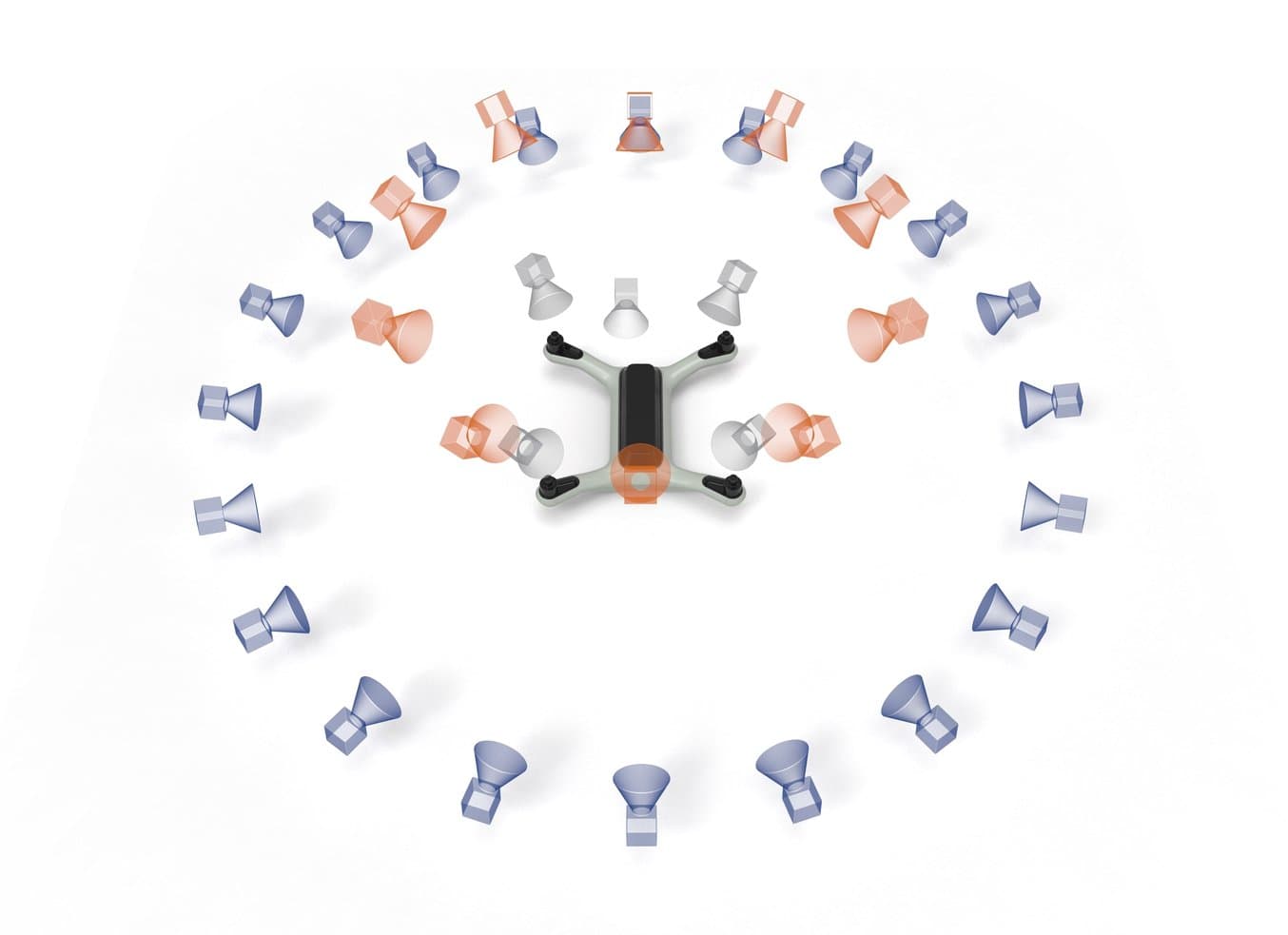
In a vintage 1964 comic book, a "processing machine" creates three-dimensional busts of Superman'southward friends using simply their photos equally input. This vision has now become an everyday reality in a series of algorithms known as photogrammetry.
From a fix of overlapping photographs, indicate cloud information is derived and processed into a fully textured three-dimensional object without the need for complex workflows or defended preparation programs. The applied science's hope: ready-to-3D-impress models with a few camera snaps and mouse clicks. Piece of cake as information technology sounds, at that place remains a fleck of an art and science to the photogrammetry workflow.
This guide will take readers through the basic steps of the photogrammetry workflow and offer several alternatives to consider in terms of photogrammetry software equipment.
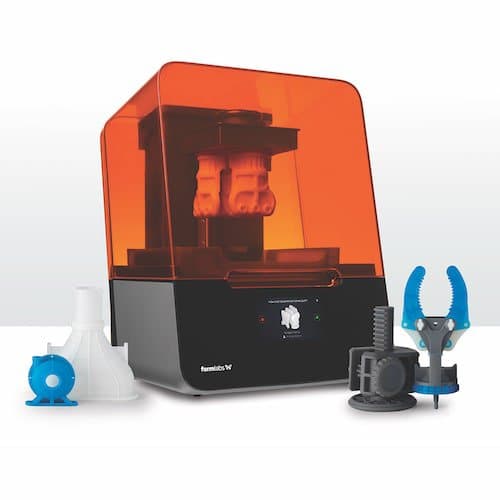
White Newspaper
Looking for a 3D printer to realize your 3D models in high resolution? Download our white newspaper to learn how SLA printing works and why it'southward the nigh popular 3D press process for creating models with incredible details.
Download the White Paper
Photogrammetry literally means the human action of deriving precise measurements from photographs. Information technology involves taking a set of overlapping photos of an object, building, person, or environment, and converting them into a 3D model using a number of computer algorithms.
Photogrammetry is used in numerous areas of application:
-
Architects apply photogrammetry for site planning, construction monitoring, and visualization rendering.
-
Artists can document or convert a piece of an existing artwork, sculpture, or nature into something new.
-
Archeologists can virtually map out and explore undiscovered areas of the world'due south lands and oceans.
-
Designers and engineers who need to contrary engineer an existing object or custom-fit new parts onto information technology.
-
Quality control in manufacturing processes is significantly aided past the utilise of photogrammetry.
-
Game developers tin save time designing props and environments by using photogrammetry combined with semi-automatic 3D modeling workflows.
-
Paleontologists can capture fossils and bone beds and decide the all-time approaches to exhumation, jacketing, and preservation equally well as document and share their findings. Detailed 3D maps of a site tin more easily reveal fossil locations.
-
For cartographers, geologists, surveyors, and topographic mappers, photogrammetry radically speeds up the process of mapmaking.
-
Forensic researchers tin can capture crime scenes in iii dimensions in order to gain more insight into issues such as bullet flight paths, car crashes, and witnesses' lines of sight, or to create virtual grooming environments.
-
Therapists and other medical professionals may browse parts of a patient's body for custom-plumbing equipment applications such every bit prosthetics and orthotics, shoes, and hearing aids.
-
In the field of cultural heritage, pieces and monuments can at present be preserved forever and virtually reconstructed and renovated.
-
Museum curators can establish virtual collections to concenter the public.
-
Meteorologists use photogrammetry to decide the speed of tornadoes.
-
Photographers now have an extra dimension to work with.
-
Companies that want to offering a service to 3D print models of most precious possessions, pets, or family members.
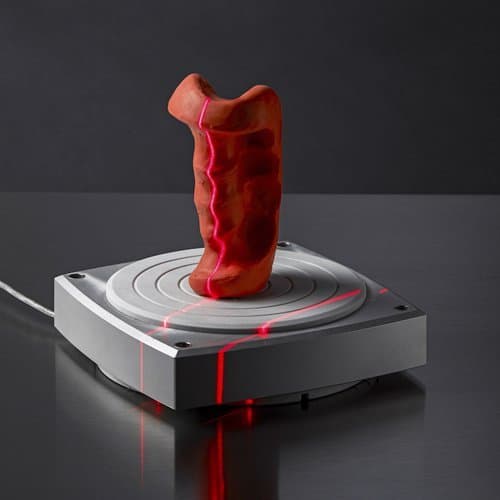
Webinar
Looking for a 3D printer to realize your 3D models in high resolution? Download our white paper to learn how SLA press works and why information technology's the nigh popular 3D printing process for creating models with incredible details.
Watch the Webinar Now
Take a serial of overlapping photos of the called object. An 8-megapixel smartphone camera will already produce adequate results for applications without high accuracy requirements, but we recommended an eighteen MP (and upwardly) DSLR-type camera for best results. A wide-angle camera is best since it presents the least lens baloney. A fish-eye lens will non piece of work, for instance, unless working with software that can intelligently compensate for this.
It is all-time to take the photos sequentially in a circle around the object. Start with a circumvolve at a low angle, then exercise ane more than at a higher angle to capture the topmost surfaces. Aim for at least 50% overlap between each prototype; 60-80% is ideal. Lastly, brand certain to take a few boosted photos of areas that hold important details.
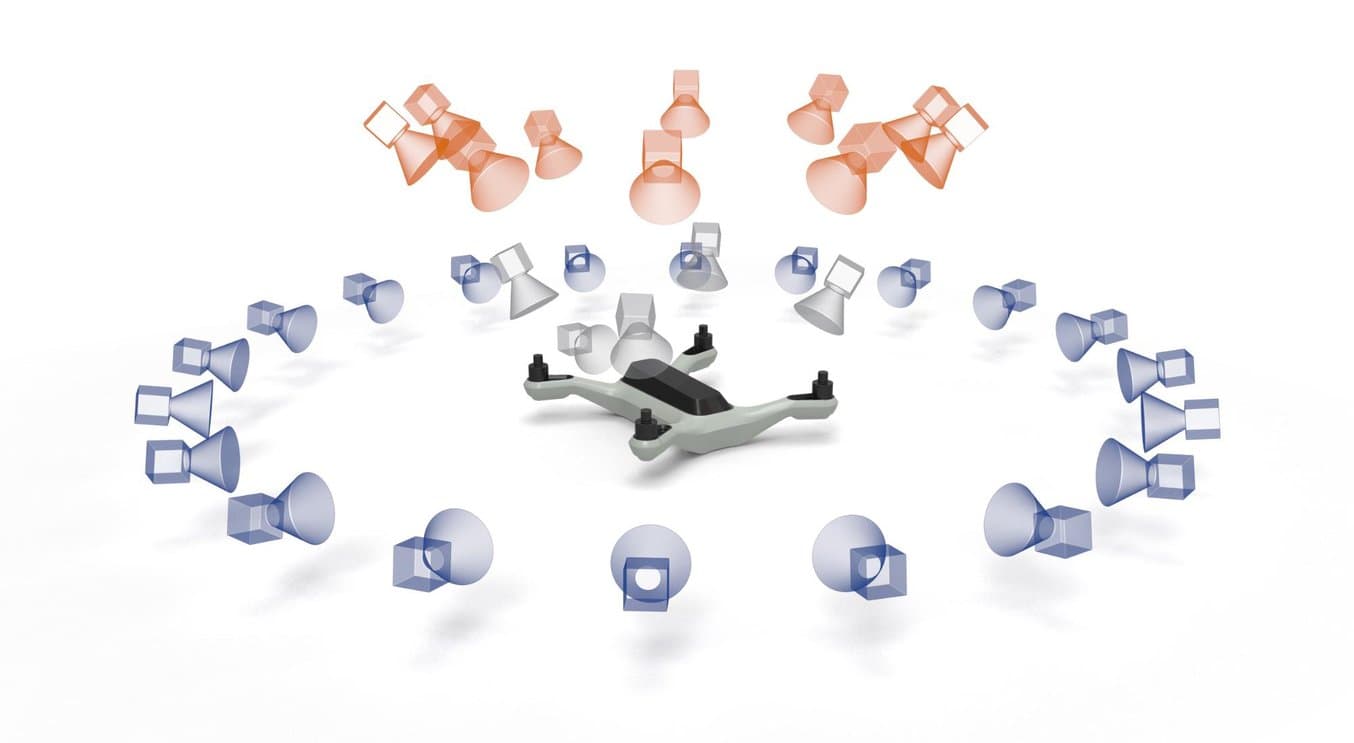
Since nosotros are not using our drone for photogrammetry, we might as well contrary engineer it. Take photos in two bands of about 10 (bluish) and 45 (orange) degrees of height, including some close-ups (grey).
Accept the following additional guidelines into account:
-
Make certain the object has a matte surface. Transparent objects will not catechumen well. Reflective surfaces tin can be converted in matte using 3D scanning spray or dry shampoo spray.
-
Some software applications do non procedure characterless surfaces well. Shoe polish, sprayable chalk, painter'due south tape, and rock effect spray paint all improve surface scannability.
-
The groundwork of the photos needs to accept sufficient color contrast with the object. A chroma-key properties works great, as does a newspaper as long as it does not evidence the same colors as nowadays on the object.
-
Lighting has to be consequent throughout the shoot and is optimal on a cloudy day.
-
40-l photos are typically enough for one object. The more photos, the meliorate, as long as they are never taken from the same position.
-
The subject field has to take up a meaning portion of the image space.
-
Never move the object during the shoot.
-
Use as little depth-of-field (DOF) as possible and focus the camera exactly onto the object for each picture.
-
Utilise a tripod to reduce blurriness as well as for depression-lit environments that require high exposure times.
-
Although they are apace getting faster, photogrammetry software algorithms can take hours or even to days to generate authentic results depending on the size of the dataset. Recommended is a computer with 16Gb of RAM and an Nvidia CUDA-enabled GPU.
Open your photogrammetry software of pick and import the photos direct into the projection library. This is usually a simple affair of drag-and-drop. For some programs, it is of import to check the compatibility of the camera. They may check them with an internal database and then the program tin optimize its results based on aspects like focal length, primary point, and image sensor format. This generates a number of distortion parameters known as a bundle adjustment.
In the first footstep of the software pipeline, the photos will exist checked on suitability to the photogrammetry procedure. For example, a green or red icon may appear side by side to or on top of the photo in the library. In case a significant portion of the photoset gets rejected, and shooting a new gear up is problematic, some Photoshop editing may do the pull a fast one on. This happens usually with white wall backgrounds. Creating a mask chosen a garbage matte for each image works to separate the foreground from the background more. Sharpening the photos may also improve results since the software will discover matching features amend across photos if they are more equal in sharpness.
Most of the computational office of photogrammetry is washed automatically in the background by the photogrammetry software, but advanced features tin help improve the results.
Most photogrammetry software suites develop the photoset fully automatically into a 3D mesh. However, some have Paradigm Matching, too known as Correspondence Search, every bit a separate step to exist confirmed past the user. This allows alterations to the photoset before starting the more computationally intensive processes. In this stride, the figurer determines which photos are useful for further processing and finds overlapping areas in multiple images. It now stores how the images will stitch together, like to putting together a 3D puzzle.
Again, in some programs, this is a fully automatic office of the photogrammetry workflow. In other photogrammetry software programs, it is possible to separate this step for possible tweaks and iterations before continuing. In this pace, the software scours the photos for features that can be uniquely recognized beyond multiple images. Several professional person toolkits use coded markers for this, a very accurate method that even works on cogitating, transparent, and otherwise featureless surfaces. Nigh tools, yet, utilize the more generic Structure from Motility (SfM) technique which generally looks for dense textures on objects, such as texts, forest grain, facial features, and other patterns. Other important features are edge points, lines, and corners. Some solutions further enrich the information with lighting and shading cues, an advanced technique known equally Shape-from-Shading.
After all features accept been found, they are internally verified to sift out erroneous detections in a stride known as Geometric Verification. To ensure that the detected features fall onto the same scene point, the SfM engine creates a transformation that maps feature points between images. This is a highly complex set of algorithms based on projective geometry.
Some photogrammetry software such as COLMAP allows the user to watch the feature generation process happen equally it takes place. In Meshroom, it is possible to stop the procedure in example the user sees important areas where trivial features accept been found. Quality can be increased by amplifying keypoint sensitivity and matching ratio, irresolute presets, and switching the matching algorithm to A-KAZE or in some cases a brute force method.
In 1480, Leonardo Da Vinci devised a method to derive the painter'southward location from a painting. Something similar happens in this cadre part of the SfM pipeline. 3D Coordinates of the surface points are estimated based on the output of the previous phase, the scene graph. Lines of sight from the camera to the object are reconstructed resulting in what is known equally the ray cloud. The intersection of the numerous rays determines the ultimate 3D coordinates of the object.
In one case global geometry has been established by means of a sparse bespeak deject, photogrammetry software looks at the lighting and texture of the scene to create a depth map. Like a wood carver, this works all the trivial details into the 3D model in social club to brand information technology come up alive. Avant-garde programs apply a process called delighting to fifty-fifty out the lit and shaded areas for more homogeneous lighting beyond the entire surface of the model. It is even possible to contrary-calculate and cancel out ambient occlusion effects. While a realistically lit model is oftentimes more desirable for on-screen visualization purposes, a delit model is better for full-color 3D press.
Then, both the and then-called dense reconstruction involving the depth map, and the sparse reconstruction that mapped out all visual features detected in the earlier stages, are combined into a 3D mesh format such every bit FBX, OBJ, PLY, or STL.
The triangulation phase takes place automatically. The user can increase quality by elevating settings such as Track Length, Nr. of Neighboring Cameras, and Maximum Points. Some photogrammetry programs too allow the user to determine the number of triangles present in the 3D mesh object which influences file size and ease of post-processing. Note that altering these settings needs to exist washed with care since they can rapidly multiply processing times.
Some professional photogrammetry software tools apply additional automobile learning techniques to classify detected objects such as leaf, buildings, and vehicles. They can filter out moving background objects such as birds and pedestrians, and establish enhanced shape data based on additional information like foreground silhouettes, reflectance, and irradiance. Thin shapes such as steel frameworks and ability lines tin can automatically exist recreated in 3D using so-called catenary curve fitting algorithms.
While the computational part of photogrammetry is an involved process, information technology is really the easiest part for the user, who often simply has to drag in their images and push button a few buttons. The real work starts when the 3D model has been generated. In no case does photogrammetry evangelize a ready-to-3D-print, watertight mesh model. There are usually floating artifacts, background noise, holes, and irregularities to make clean up. The object volition also need to be reoriented and rescaled, which is done quite arbitrarily past photogrammetry software.
Some software packages have in-built mail service-editing tools, otherwise, a sound workflow is to practice the necessary file conversions in Meshlab and the mesh cleanup, repairing, remeshing, and resculpting labor in MeshMixer. All of these programs are complimentary for commercial apply.
When this step is washed and the file is saved into STL format, the object will be ready for 3D printing or import into a CAD environment.
For more information on mesh repair, visit our in-depth MeshMixer tutorial.
In recent years, photogrammetry software has arrived that is easy to use, cost-constructive, and results in models that actually resemble the original. Developers are making quick iterations to add together the necessary features to optimize the meshing process and fix errors.
When the photography is done well, several free tools will suffice to meet the needs of basic photogrammetry projects. So at that place are consumer-level tools based on a one-fourth dimension purchase for a perpetual license that offers more than advanced features and somewhat more than reliable quality. Professional tools are priced exponentially higher but in return offer flawless results and advanced features such as AI-driven feature recognition and model reconstruction, laser scanning compatibility, video-based photogrammetry, unlimited dataset sizes, marker-based captures, and/or tools to enable drone-based aeriform photogrammetry.
| Quality | Speed | Features | User-Friendliness | Price | |
|---|---|---|---|---|---|
| 3DF Zephyr | ★★★★☆ | ★★★☆☆ | ★★★★★ | ★★★★☆ | ★★★★★ |
| Agisoft Metashape | ★★★★☆ | ★★☆☆☆ | ★★★★☆ | ★★★☆☆ | ★★★★☆ |
| Autodesk Epitomize | ★★★★★ | ★★★☆☆ | ★★★☆☆ | ★★★★★ | ★☆☆☆☆ |
| COLMAP | ★★★★☆ | ★★★★☆ | ★★☆☆☆ | ★☆☆☆☆ | ★★★★★ |
| iWitness | ★★★★★ | ★★☆☆☆ | ★★★☆☆ | ★★★☆☆ | ★★☆☆☆ |
| Meshroom | ★★★★☆ | ★★☆☆☆ | ★★☆☆☆ | ★★☆☆☆ | ★★★★★ |
| Qlone | ★★☆☆☆ | ★★★★★ | ★★☆☆☆ | ★★★★★ | ★★★☆☆ |
| RealityCapture | ★★★★★ | ★★★★★ | ★★★★☆ | ★★★★★ | ★★☆☆☆ |
| Regard3D | ★★★☆☆ | ★★☆☆☆ | ★★☆☆☆ | ★★★☆☆ | ★★★★★ |
| VisualSFM | ★★★☆☆ | ★★★☆☆ | ★★☆☆☆ | ★★★☆☆ | ★★★★★ |
Autodesk'south Recap software is the virtually sophisticated in its form, and originally stems from an application they acquired in the early 2000s chosen RealViz Image Modeler. They transformed it into the free Project Photofly, which later became the deject-based 123D Catch. After a few years, Autodesk decided to monetize their software in the form of Autodesk Remake, which got rebranded and remonetized with the latest launch of Recap.
Autodesk's photogrammetry algorithms are almost unparalleled in the industry and evidence to be at the top of delivering direct 3D printable scans. The automated cleanup function is infrequent and several mesh editing tools are available to speedily prepare models for AR/VR platforms. For game developers in that location is the nifty choice to directly output bump and deportation maps. The user interface feels like an piece of cake-to-use app even though there are still a few small flaws such as the lack of a progress indicator bar while waiting. While delivering cutting-edge results, given the toll bespeak and restriction to deject-based processing, Autodesk Recap is not an obvious choice for the starting photogrammetrist.
RealityCapture is a peachy solution that delivers highly authentic scan results. What sets it autonomously from the others virtually is its mercurial processing speed. Where other solutions fail or leave the user with substantial waiting times, RealityCapture consistently delivers lightning fast results, even with enormous datasets. It is besides less heavy in using RAM resources than other software. The price for a perpetual license is on par with that of other professional solutions, fifty-fifty though the version that includes light amplification by stimulated emission of radiation scanning is much more costly. An alternative is a PPI (pay per input) plan, which lets the user access all functionality for gratis, until they desire to salvage the results.
The user interface feels similar a professional editing environment and provides many options, grouped per stage of the photogrammetry pipeline. The tab and panel-based, fully configurable user interface will feel very familiar to the mainstream client and seems to have derived its inspiration from Windows and Autodesk software platforms. There are clever gizmos and option tools, more than being added with every update. Novice users are offered a one-click approach, while there are plenty of options for the budding specialist. The optimization and direct export to Sketchfab is a handy addition. One flaw is that while it repairs meshes quite well, the user has no command over pigsty patching other than that all holes are automatically patched by the program. For boosted levels of control the user will have to reside to external tools such as Netfabb or MeshMixer. For mechanical objects that include apartment surfaces, RealityCapture tends to produce somewhat noisy results and to recoup offers a Smoothing tool. The algorithms lend themselves all-time for scanning organic objects without planar features.
Agisoft is a Russian enterprise and while on the surface their software looks substandard with a dated Windows-style user interface blueprint, the results are highly reliable and comparable to those generated past Autodesk Epitomize. For scanning mechanical objects with apartment surfaces, Metashape produces slightly less noisy mesh results than RealityCapture, but can also result in less detailed meshes even though information technology takes three times as long. It also has the about bug with directional rim lighting which tin result in substantial holes. The advice to shoot only in cloudy atmospheric condition is of paramount importance hither.
The standard version of Metashape costs under $200 and already enables photosets of up to one,024 images which is merely unsuitable for projects of stellar scope such equally capturing entire building interiors or geographical settings. Price-wise, the professional version lies in the same range as other solutions, and offers detailed depth mapping, marker-based scans, manual photo alignment, machine learning-assisted geometry generation, and cloud processing. Nonetheless, the standard version's options are surprisingly comprehensive. Even though they are zip avant-garde, several options for hole patching and mesh repair are present. There are possibilities for video data import, batch processing, panorama, and flythrough video creation. The program is not restricted to NVIDIA CUDA-enabled GPUs similar RealityCapture is. The UV-unwrapping of textures is performed very logically, making textures Photoshop-editable unlike with most other photogrammetry solutions. There is a two.5D-manner, which offers a great speed boost for scanning surface textures compared to the regular photogrammetry procedure.
To top it off, Metashape is one of the few environments that allows external mesh editing and the subsequent re-importing of the model into the photogrammetry studio. Whereas it offers no retopologize or sculpting tools similar Epitomize does, it is entirely workable to do advanced mesh cleanup, repairing, remeshing, and resculpting labor in MeshMixer. For more advanced sculpting options utilise the free Sculptris or its professional cousin Zbrush.
Meshroom is a free and open-source photo-to-solid solution that relies on an advanced computer vision framework called AliceVision. The nodular interface is somewhat obscure and takes a while to main. Once the user learns which parameters to alter in the submenus and how to reroute certain nodes, it is relatively easy to produce meshes of progressively more refined quality. Instead of a linear pipeline, multiple SfM modules can be run in parallel and later combined for a more than robust mesh. This offers the benefit of additional control over the final mesh quality. While professional users become the full nether-the-hood view, novice users do good from simply hitting the Start button afterward photo upload, and letting the figurer practice the rest. The program gets dull only at the highest settings.
All in all, Meshroom is one of the all-time free-and-open up-source (FOSS) solutions to photogrammetry and generally produces good quality meshes. It offers no mesh editing tools so the user needs to rely on third-party offerings here. Also it tends to reject a substantial percentage of camera positions so it is paramount to attach to proper photography guidelines. A nice characteristic is that photos can be shot and added on the fly to improve scan results. Every time the Meshing module is activated, an OBJ format 3D model is automatically generated in the output folder. This enables rapid iteration cycles.
Zephyr by 3Dflow is a renowned editing studio with a professional person toolset and user interface. For those starting with photogrammetry it offers a sorcerer that guides users through the procedure co-ordinate to their level of expertise and blazon of photogrammetry project (close-range, urban, human being trunk, or aerial). The costless version works with a maximum of 50 photos which is an acceptable corporeality for single-object photogrammetry. The affordable Low-cal version shoots that number up to 500, while the full version offers an unlimited photoset size.
Zephyr is non a fast solution. A default browse takes about two hours and for a high-quality scan count on an overnight expect. For ultimate quality, in that location is an 'Ultra' option under 'Settings' which is subconscious for the mainstream user because of potential calculator lock-ups. Zephyr is full of handy features such as texture sharpening, hole capping, retopology, smoothing, Sketchfab upload, video import, and a transmission masking tool called 'Masquerade' that aids separating the foreground object from the background in challenging projects. The Pro version provides the options of coded targets, batch processing, laser browse alignment, and outputs STL and Collada files besides the regular OBJ and PLY formats. 3DF Zephyr runs on any Windows PC with DirectX.
Colmap is a free photogrammetry solution originally developed for research purposes. Combining a GUI with control-line functioning, it is by and large geared to the professional user. For starting users the technicalities tin seem intimidating, yet the Automatic Reconstruction mode is there to help out. Colmap is suitable for both close-range and large-scale projects, and volition require external software for mesh repair operations. It is Windows-merely and volition require an NVIDIA graphic menu. The upside is that Colmap offers many advanced options in order to generate high-quality meshes.
Regard3D is a free fiddling program that takes users through a serial of Windows-style user interface panels that guide them through the photogrammetry pipeline. Several settings are available in each footstep, which is farther explained on the Regard3D website. It includes several different procedures such as structure from motion, multi-view environment, and surface reconstruction. It is up to the user to experiment with these and generate optimal scan results. Note that Regard3D will only work with cameras known to its database, which excludes some older smartphones. Crashes are uncommon but can occur with big datasets or likewise avant-garde settings. The software exports either a point deject in PLY format or a triangulated mesh in OBJ format.
VisualSFM is a photogrammetry solution that is free for non-profit purposes, and was written past a Google engineer. The densification algorithms that convert feature matches into point clouds are similar to those used by Regard3D. The user interface is operated either through a command-line interface or icon-based buttons which requires some prior knowledge. A nice feature of VisualSFM is its zoomable user interface that lets the user scan through large photosets very easily. The user is also able to lookout man a live point deject reconstruction, with every camera individually selectable and visually linked to its original photo. Information technology makes waiting for results a flake more bearable. There are tons of tweaking options for the avant-garde user, while for beginners it suffices to simply printing four buttons. Note that VisualSFM's output is a point deject in PLY format which needs further conversion into a mesh by external tools such every bit Meshlab.
iWitness is a professional person photogrammetry suite developed by Australian enterprise Photometrix. Because it can incorporate Ground Control Points (GCPs), for case derived from GPS data, it is especially suited for big-scale applications in architecture, surveying, blow reconstruction, and forensic investigation. The algorithms are very precise and tin can effect in iii-dimensional betoken clouds that are mapped to the photoset with unmarried pixel precision. iWitness is also useful for close-range photogrammetry and reverse engineering. With the right preparations, information technology is possible to browse objects equally small as coins in full detail. The learning curve is fairly low every bit beginning users can obtain a total 3D browse using only 5 toolbar buttons of its Windows-style user interface.
The standard version of iWitness costs around a thousand Us dollars and includes all major functionality. The primary drawback is that it simply allows users to process up to xl images. This number jumps to unlimited in the PRO version which costs well over twice the amount as the archetype version, simply also offers retroreflective coded target support as well as cloud computing. Information technology also has a feature that automatically generates a network of 3D curves and polylines for straight export to CAD environments using the DXF file format. Alternatively, this characteristic allows one to browse a two-dimensional drawing on paper, and convert the result to DXF for CNC routing or laser cutting.
Photomodeler is a loftier-finish software parcel that offers a myriad of tools. Information technology is highly suited for CAD integration and includes a Rhinoceros plugin. There are tools for pattern digitization towards CNC or soft appurtenances manufacturing for fashion, boat sails, or upholstery, to proper noun a few applications. Several manual modeling tools can directly produce mesh surfaces to match geometry such as cones, cylinders, rectangular features, and lofted surfaces. The automatic point cloud generation process is based on the MVS algorithm which results in accurate textured results that tin can be exported to many different file formats.
Setting up a project is done by means of a wizard that offers the right options at the right phase. Photomodeler's Standard version comes at a price just under a 1000 US dollars. The premium version triples that amount and offers more than smart features, better dense surface modeling, as well equally UAV/drone back up.
Photomodeler is non strictly a photogrammetry editor though, since it relies on an entirely different method for object reconstruction. Information technology is based on taking a minor set, three or iv, images at perpendicular angles to an object, and using coded markers and manual input in order to reconstruct the object rather than an automatic photograph-to-solid workflow. It will only be suited for specific professional applications, not for opposite applied science.
This overview wouldn't be complete if it did not include a mobile photogrammetry app. It is there in the course of Qlone. Given that mobile photogrammetry platforms are in their infancy, Qlone does a decent job. Users can run across the results being generated within a few minutes, which subsequently tin can be exported for view in Sketchfab, embedded into AR applications, or converted to a 3D printable model and directly transmitted to an online 3D press service provider. There is a gratuitous version that produces low-resolution models. The premium version and in in-app purchases add together high-resolution scans and unlimited exports to OBJ, STL, X3D, and PLY, as well equally AR viewing.
To convert a smartphone into a working photogrammetry unit does require an outstanding camera, plenty of GPU processing power, and sufficient internal storage. Models are best photographed on a Qlone-specific scanning mat. To beautify mesh results, Qlone offers remeshing, sculpting, and smoothing tools. A extra feature is automatic GIF creation for sharing animations of the object on social media. Note that the iOS-app includes more functionality compared to the Android version.
This department will focus on close-range photogrammetry for reverse engineering science in the context of production pattern and evolution.
Contrary technology is a powerful way to create digital designs from a physical part, and tin can be a valuable tool in the prototyping workflow alongside technologies like 3D modeling and 3D printing. It is increasingly used to retrofit parts and installations to boat decks, aircraft, cars, kitchen cabinets, swimming pools, stairs, pipage, and industrial mechanism. The major advantage of photogrammetry here is the fast non-contact workflow also as the low expertise and low-budget equipment needed. Since designers volition at times want to browse an object for derivative purposes, we volition show hither how it works for a generic reckoner mouse. This is a challenging object to browse and generate a highly precise model because its surfaces are by and large organic and featureless.
After weeding out unsharp images, the terminal photoset consists of 41 photos, shot with a Motorola G9 Play smartphone in fully overcast daylight. Since a featureless matte surface fails to generate any workable results, the object was covered with marble outcome spray paint. This speckles the object, rendering it perfect for photogrammetry, more than then than other methods. As an underlay we establish a characteristic-rich illustration on a matte paper with contrasting colors and clear reference shapes to work best.
We selected the almost promising software tools based on their suitability for opposite engineering, automated workflow, high-quality results, affordability, and direct mesh export: 3DF Zephyr, RealityCapture, COLMAP, Meshroom, and Regard3D. Nosotros take besides used the Qlone app to try a mobile focused solution.
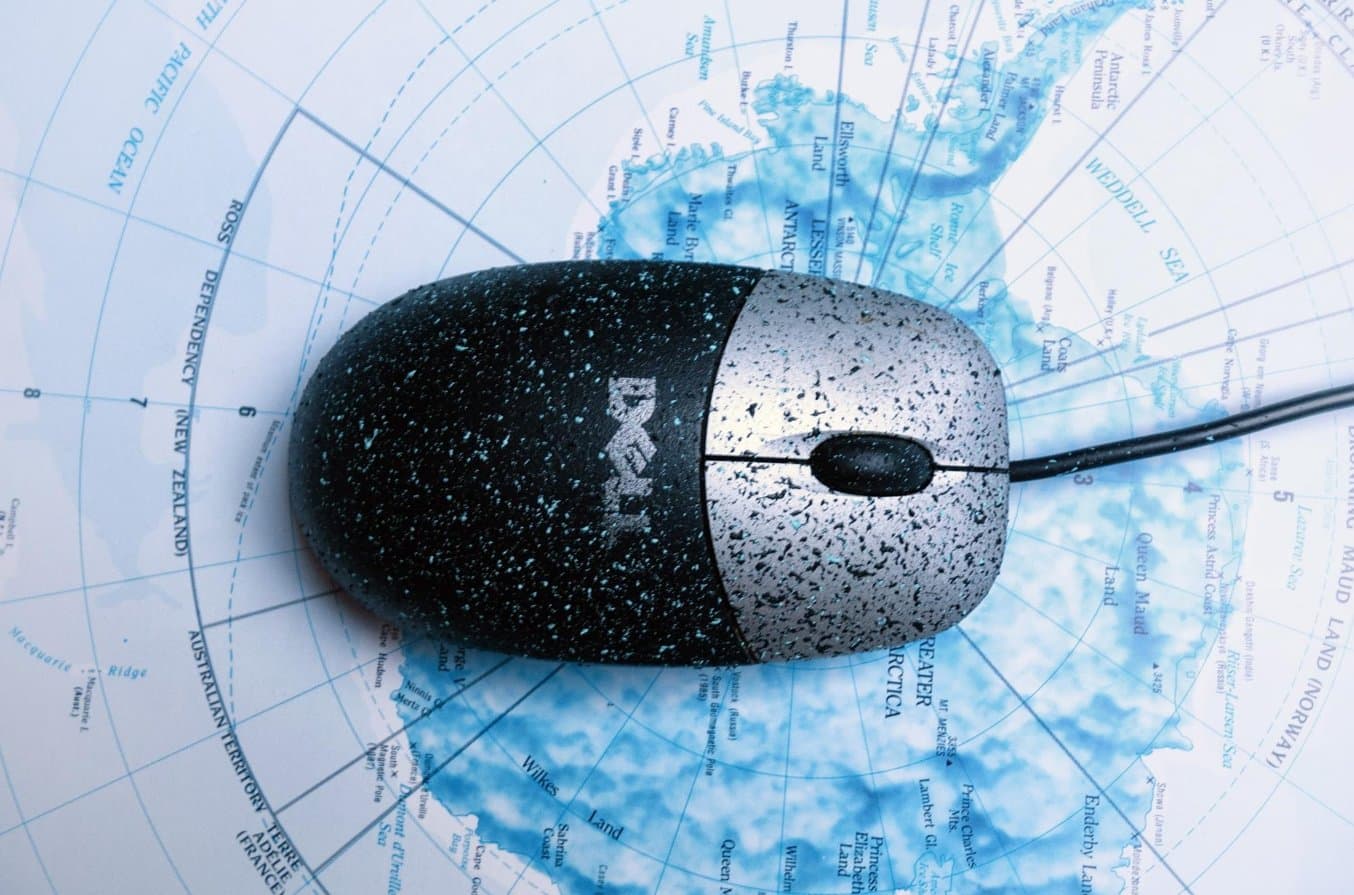
Our object of photogrammetry, a Dell M-UVDEL1 Wired Optical Mouse, prepared with marble spray paint and positioned on an underlay of the Antarctic continent.
In all the software suites, we selected the preset or setup that is mostly regarded to deliver loftier quality results. We have also tried a few of the Ultra setups such as offered by Meshroom and Colmap, but these improved the results only marginally while increasing processing time by up to 400%.
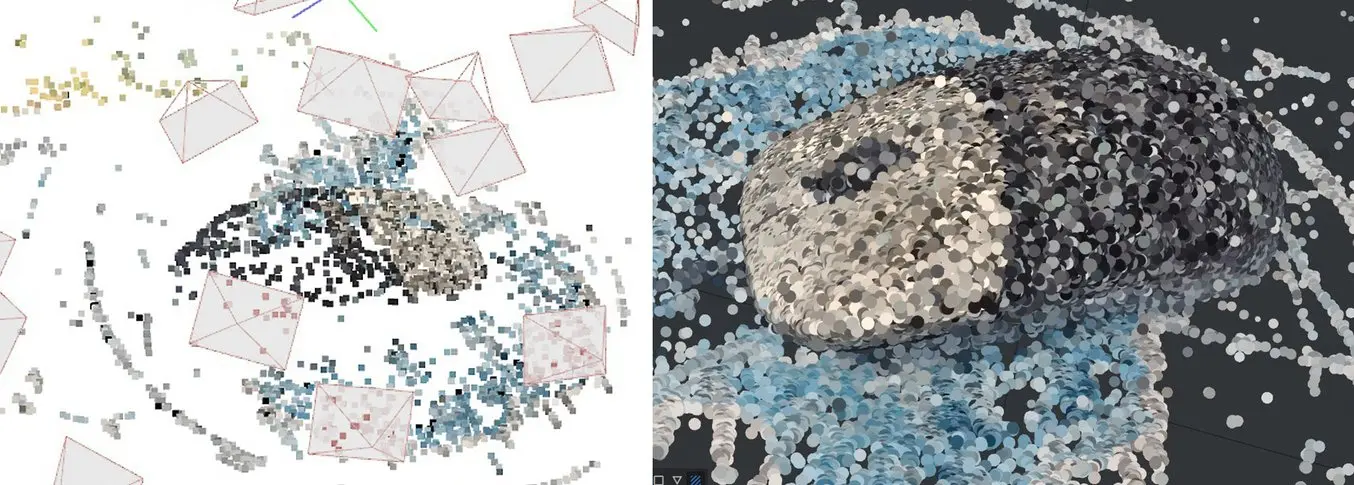
Left: feature matches constitute by Colmap. Correct: feature extraction by Meshroom.
Meshroom finds significantly more feature matches than other software systems and delivers precise results. Once familiar with setting the parameters, it is easy to tune the quality to specific wishes. The downside is that the High preset took 76 minutes, which is irksome in comparison, notwithstanding still very workable. The Ultra setting is all-time planned for an overnight session merely does yield somewhat amend output. Results tin come out a bit glitchy, which requires some experimenting with proper settings and algorithms. In the High preset, the shape is compiled completely and accurately when it comes to overall dimensions. Low-lit areas are sufficiently reconstructed. The resulting mesh is relatively coarse when it comes to detail and quite grainy in terms of surface texture. The cord was missing entirely, and the mouse wheel came out a bit jumbled. Of all programs tested it does come in 2d place for all-time rendering the overall shape, which will exist relevant for contrary engineering parts with complex or organic surfaces.
For generating workable results fast, Colmap is the best solution. It generated a high quality mesh in just 14 minutes. Details and edges are conspicuously visible although operation in low-lit areas turned out more problematic. At that place were some erroneous protuberances in the resulting mesh object here and there, but null that can't be fixed.
Regard3D took 23 minutes to produce a less detailed rendering of the computer mouse. The mesh came out with a number of dimpled areas, and the environment contained a multitude of floating alien bodies —not literally, of course. This effect became less noticeable after increasing the quality to a higher setting, although the computer mouse stayed more or less the same. Apart from the mouse itself, it did return the cord almost completely, and while on a higher quality setting the processing speed tripled, the quality of the periphery increased significantly. Information technology appears to u.s. that Regard3D excels at scanning spaces rather than private objects.
3DF Zephyr scored reasonably decent in all regards. Afterwards just 20 minutes of processing, the overall shape shows up entirely, surfaces are merely slightly dimpled, well-nigh details are nowadays yet somewhat coarse, and the ground plane and cord are rendered very well. When checking the hidden 'Ultra' setting, processing time quadrupled without any visible improvements to the mesh when compared to the i generated in 'High Quality' manner. This mesh was over 500Mb, more than than five times heftier than the other programs' results. Since the surface is relatively polish, it will be easy to decimate the mesh towards a smaller file size though. Low-lit areas are rendered exceptionally sharply, which may work best when photograph-scanning objects with deep cavities and crevices.
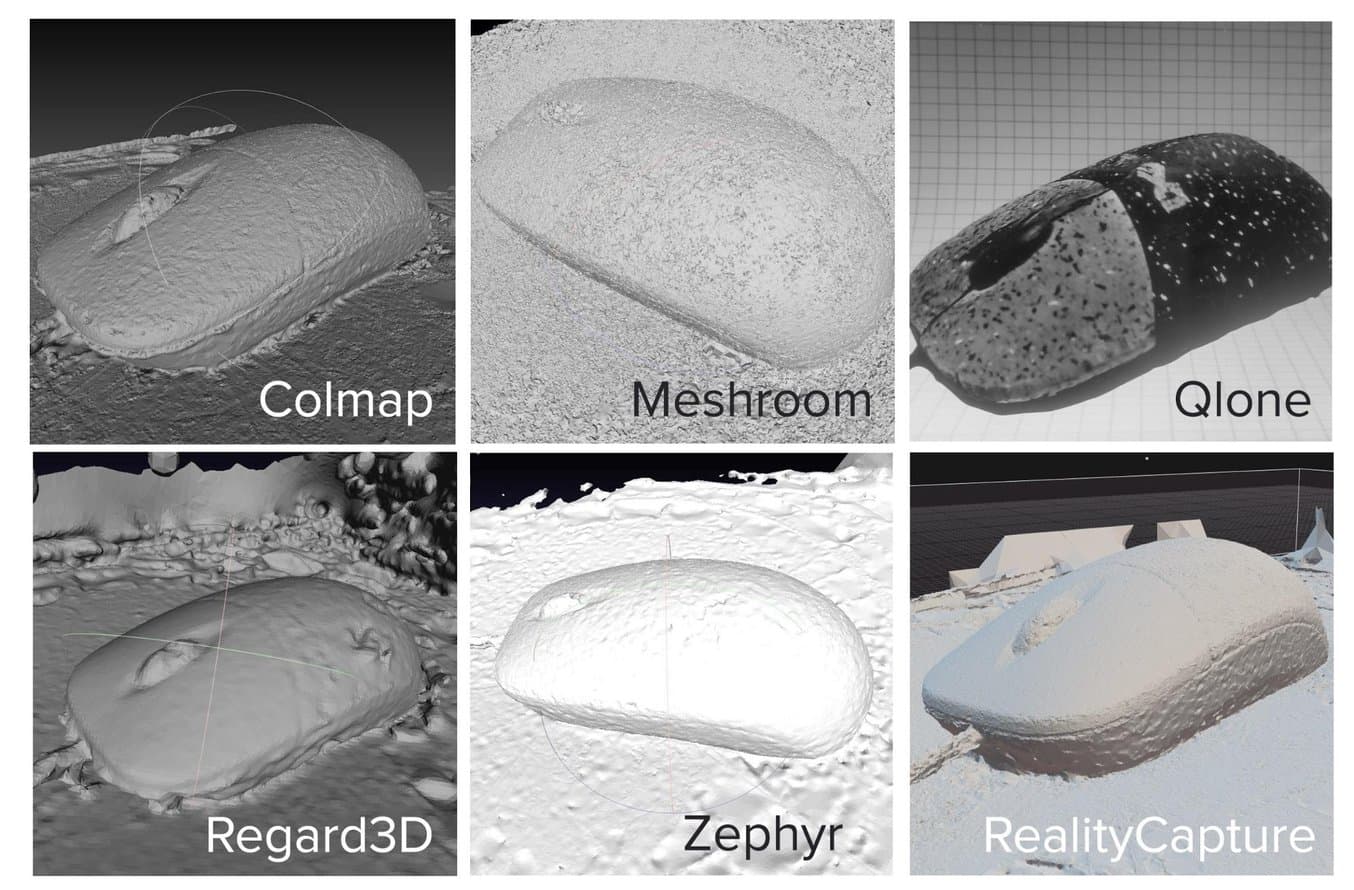
Resulting meshes from the chosen photogrammetry solutions Colmap, Meshroom, Qlone, Regard3D, 3DF Zephyr, and RealityCapture.
Unsurprisingly, the Qlone app scored relatively poorly. The scanning process takes approximately five minutes, with subsequent processing absorbing about twenty minutes and a quarter of the phone battery. When judging by the untextured results the shape is only accurate in its footprint outline. The topmost area became more pyramidal than smoothly curved. While the mouse wheel vanished entirely, the cord bit was there. The app will work best for modest figurines that need to be converted into game avails. Qlone relies on the use of a scanning mat that contains a square grid. Similar voxels, the grid squares are extruded to the appropriate meridian and in the end a smooth surface is 'fatigued' over the voxel grid akin to a canopy. It is nice that Qlone lets the user watch the surface generation process while scanning, but it is not suitable for reverse engineering.
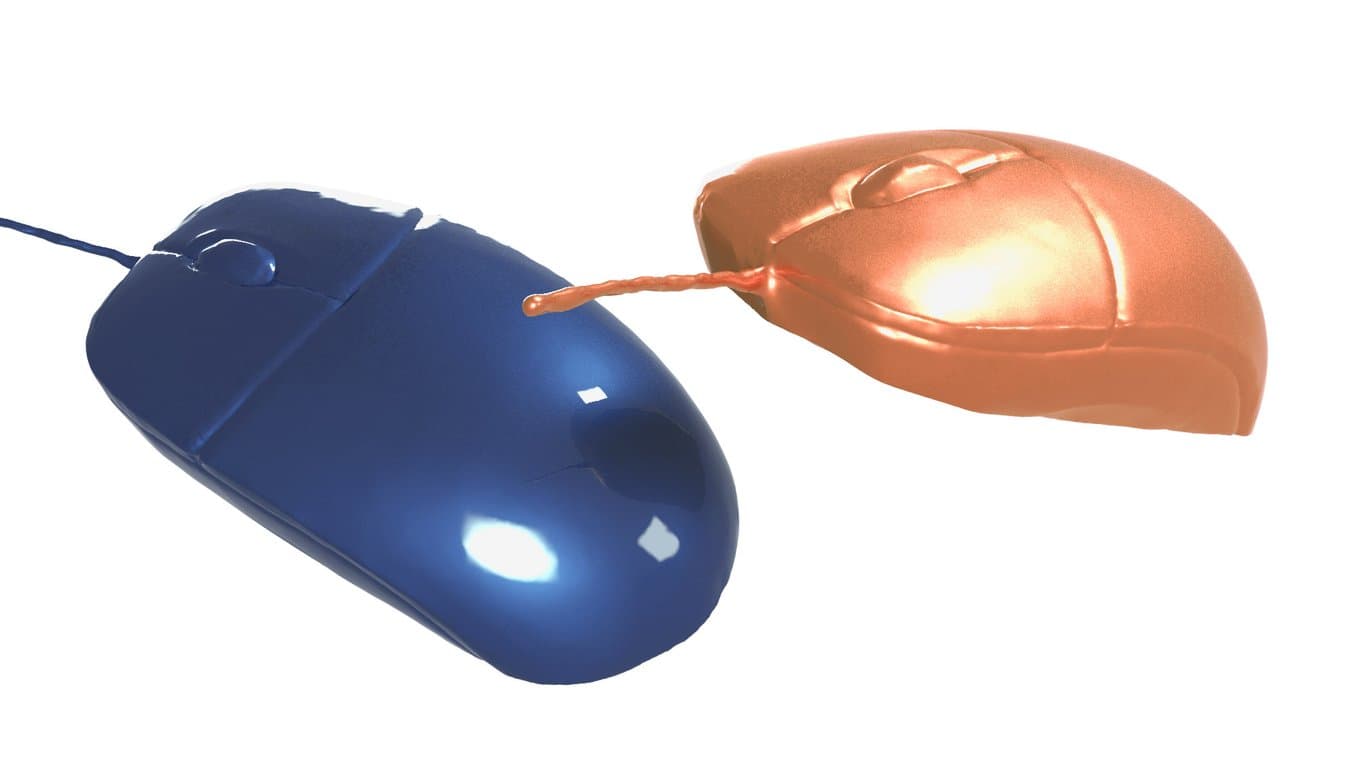
The photogrammetry-scanned estimator mouse, polished upwardly in MeshMixer and ready for CAD import.
Best results came from RealityCapture, bar none. Its results are the ultimate proof of quality differences in photogrammetry solutions, and of the fact that on a low upkeep, high-quality photogrammetric scans are possible. The overall shape came out only as good as in Meshroom or Zephyr, but all details were present and in nearly total detail. Edges were reproduced markedly precipitous, nevertheless more so than with Colmap; even the part lines and low-lit areas came out sharp. There are no floating artefacts in the output mesh which makes post-processing a breeze. With a bit of cutting and polishing, such a mesh is fix for directly import into a CAD surroundings for resurfacing and reverse engineering. The catch vs. a free open-source software solution is that RealityCapture requires customers to pay a small per-model fee on export. Without question, the quality improvements are well worth the investment.
| Shape Allegiance | Details | Noise | Floating Area | Depression-Lit Areas | Overall Performance | |
|---|---|---|---|---|---|---|
| 3DF Zephyr | ★★★★★ | ★★★☆☆ | ★★★☆☆ | ★★★☆☆ | ★★★★★ | ★★★★☆ |
| Meshroom | ★★★★★ | ★★★☆☆ | ★★☆☆☆ | ★★☆☆☆ | ★★★★☆ | ★★★☆☆ |
| Regard3D | ★★★☆☆ | ★★★☆☆ | ★☆☆☆☆ | ★★★☆☆ | ★★☆☆☆ | ★★☆☆☆ |
| COLMAP | ★★★★☆ | ★★★★☆ | ★★★☆☆ | ★★★★☆ | ★★★☆☆ | ★★★☆☆ |
| RealityCapture | ★★★★★ | ★★★★★ | ★★★★☆ | ★★★★☆ | ★★★★☆ | ★★★★★ |
| QLone | ★☆☆☆☆ | ☆☆☆☆☆ | ★★★★★ | ★★★★☆ | ★★★☆☆ | ★☆☆☆☆ |
Photogrammetry is a worthy alternative to 3D scanning that requires only a digital camera or smartphone and a software package. It radically lowers the barrier-to-entry for those wanting to create detailed digital 3D models and recreate them using a 3D printer.
Information technology takes a bit of experience and most probable a few tries per projection in order to create a workable photoset. The object to be digitized will likely also need some alterations like matting or texturing to get in scannable. This guide also evaluated a multitude of photogrammetry offerings currently on the market. We have seen substantial differences in quality, user-friendliness, operating speed, affordability, and smart features. Fifty-fifty though we have excluded aerial applications from the article, some programs such as iWitness and Qlone are clearly targeted towards specific user groups and areas of application while others such every bit 3DF Zephyr, Autodesk Recap, and RealityCapture offering a more generic fix of tools useful across many areas of application.
When 3D printing digital models using a high resolution 3D printer, such as stereolithography printers from Formlabs, the detail level embedded into the browse will be the critical factor, since the printer volition exactly reproduce all minute details. Processing speed and user friendliness are secondary factors that determine how well the software can be built into the pipeline. Some special features volition enable primal applications, for instance conversion into CAD data for further customization, alignment with light amplification by stimulated emission of radiation scanner data, 2/2.5D blueprint digitization modes, object detection, and the ability to reproduce flat and cylindrical surfaces. The direct incorporation of mesh optimization features into the photogrammetry pipeline is of lower importance since these can conveniently be handled by a plenitude of freely available tools.
Photogrammetry tin can be a valuable low-budget tool for contrary technology. There will be some deviations in the lodge of 0.1-0.five mm and unwanted artefacts in the mesh. But with a flake of post-processing and trial-and-error, it will be viable for many reverse engineering projects for objects of low and medium geometric complexity. To obtain college precision, laser 3D scanning or a hybrid arroyo with photogrammetry remains the best choice.
Source: https://formlabs.com/blog/photogrammetry-guide-and-software-comparison/
Posted by: summerallwavers.blogspot.com


0 Response to "Should I Upload Panoramas To Recap"
Post a Comment